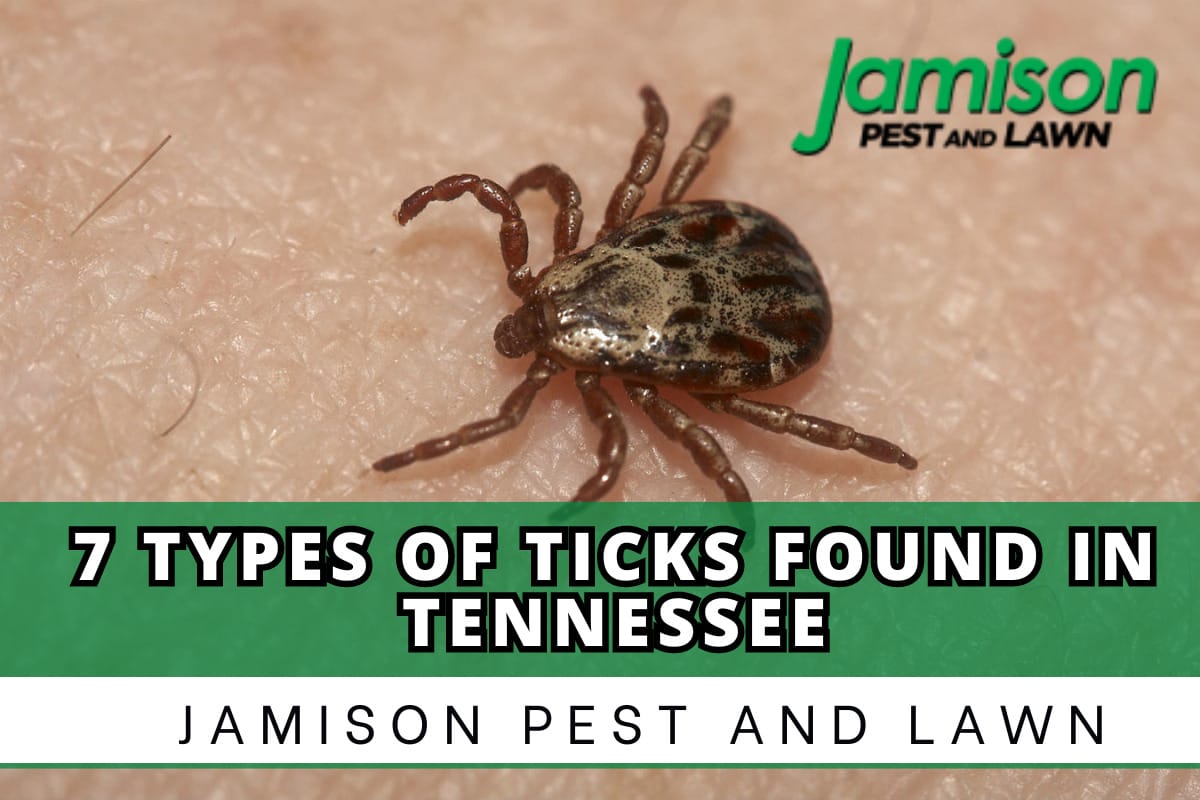Tennessee is one of the most beautiful states in America, home to some of the best waterfalls and mountains. But unfortunately, this comes with certain issues too. The Volunteer State is also home to a lot of pests such as termites, and while we have covered termites in great detail in other blog posts, today we; ‘re going to talk about another pest you should look out for: ticks.
If you have been living in this area for a long time you’re probably aware of these little creatures, but just like termites, there are different types of ticks to look out for, and each one can affect you and your pets differently.
Today we will be talking about the most common types of ticks in Tennessee and how you can tackle them.
What Are Ticks?
Before we get into the most common types of ticks, you should know what they are. Ticks are tiny bugs that drink blood from animals like mammals, birds, and reptiles. They stick onto the skin of these animals and use their special mouth to suck blood.
The Tick Lifecycle
The life of a tick goes through four stages: egg, larva, nymph, and adult. Here’s a more in-depth description of each stage:
Egg Stage:
A female tick lays hundreds of eggs at a time, usually in a safe spot within its environment. This stage, also known as stage 0, starts sometime in the spring. Once she lays the eggs, the female tick usually dies. For these eggs to hatch, they need the right conditions—enough humidity and the right temperature.
Larva Stage:
When the eggs hatch, tiny six-legged larvae emerge. This is the first active stage of the tick life cycle. Ticks do not have the necessary strength to cause actual harm in this stage, but they are slowly getting stronger. These little ticks look for hosts, often small animals like rodents or birds, to get their first blood meal. After eating, they drop off the host and grow into the next stage.
Nymph Stage:
The larvae will eventually molt and become eight-legged nymphs. Nymphs are bigger than larvae and seek out another host for another blood meal. They, too, feed on small animals. After their meal, they drop off the host and grow again to become adults.
Adult Stage:
Adult ticks, now with eight legs, look for larger hosts like deer, dogs, or humans. Once they find a host, they feed on blood for a longer amount of time compared to nymphs or larvae. After feeding they often mate, and the female ticks lay eggs, starting the lifecycle over again.
Ticks And Lyme Disease What’s The Relation?
If, like us, you are a dog lover or someone who frequently enjoys walking in nature, then ticks are most likely a big concern for you, with the primary concern being Lyme disease.
Lyme disease is one of the most dangerous diseases that ticks can spread to both humans and pets. It’s caused by a bacteria that the ticks carry called Borrelia burgdorferi, and leads to symptoms such as fever, lethargy, joint pain, and even more severe health issues if left untreated.
After any outing, you should always check yourself, and your pets for ticks to ensure that none are latching on, as they can be quite sneaky and discrete. Though not all ticks carry the disease, you don’t want to take any chances. If one is found, remove it carefully to ensure that you remove the entire pest, and contact your local veterinarian or doctor if you start noticing symptoms.
#1 American Dog Head Tick
Scientific Name: Dermacentor variabilis
These ticks are larger compared to most of the types of ticks we will discuss in the following sections and are easily identifiable too. These usually have a dark brown body, resembling the color of dark chocolate, with white or gray markings.
They tend to populate areas with grass and low-to-the-ground vegetation, becoming more active during spring and early summer. The females’ off-white patterns behind their mouths are also quite noticeable.
Though they’re not necessarily known to carry Lyme disease, these ticks can transmit diseases like Rocky Mountain spotted fever and tularemia, posing a risk to both humans and animals.
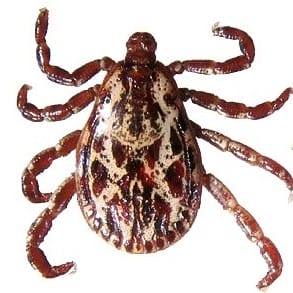
#2 Asian Longhorned Tick
Scientific Name: Haemaphysalis longicornis
Though these ticks have the word Asian in their name, they are found throughout the states, especially in eastern areas and parts of Tennessee.
They’re often found in grassy, wooded areas, and pastures, thriving in both rural and urban environments during warm months. Despite their small size (similar to a sesame seed), they can pose significant risks due to their ability to reproduce without mating, leading to fast-growing populations.
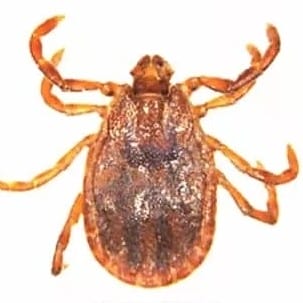
#3 Black Legged Tick
Scientific Name: Ixodes scapularis
Black-legged ticks are dark brown or black in color, and after a blood meal, females display an orangish-red abdomen. They are quite small, about the size of a sesame seed, with black legs, hence their name. These ticks are commonly found in wooded areas with dense vegetation and are most active during warmer months. They are carriers of various diseases such as Lyme disease, anaplasmosis, babesiosis, and Powassan virus, making them a significant health concern.
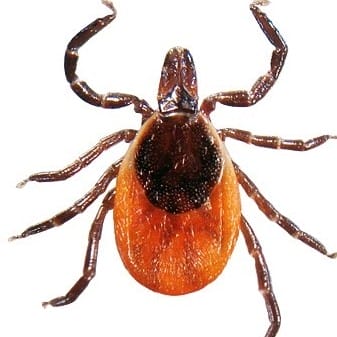
#4 Brown Dog Tick
Scientific Name: Rhipicephalus sanguineus
The brown dog tick, as its name suggests, has a reddish-brown color and is one of the most common types of tick worldwide. You’ll often find them in places where dogs spend time, like kennels or homes with pets. While they can be active throughout the year, they particularly thrive in warmer temperatures.
They have elongated bodies and turn dark brown after feeding. Brown dog ticks can transmit diseases like canine ehrlichiosis and canine babesiosis, which can affect the health of our furry friends. As far as humans are concerned, there isn’t much evidence to suggest that these ticks pass on serious diseases.
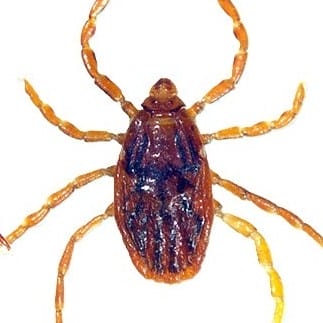
#5 Lone Star Ticks:
Scientific Name: Amblyomma americanum
Lone star ticks have a brownish appearance and are easily recognized by the white or silvery spot (resembling a lone star) on the back of female ticks. The males, on the other hand, have a brown body with streaks or patches.
Like most of the other types of ticks on our list, you will usually find lone star ticks in areas with tall grass or shrubs, like your backyard. Their active period also typically aligns with warmer months, from spring to fall. Lone star ticks can transmit a host of diseases like ehrlichiosis, tularemia, and a unique allergic reaction to red meat known as alpha-gal syndrome.
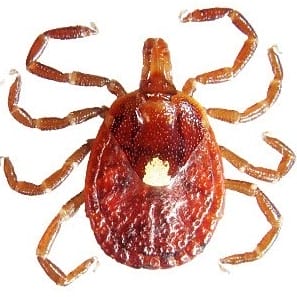
#6 Gulf Coast Tick
Scientific Name: Amblyomma maculatum
The Gulf Coast tick lives in the southeastern United States, and can be found in abundance near the Gulf of Mexico. It has a reddish-brown body with white or yellow spots on its back. These ticks prefer warmer weather and hang out in grassy areas with low bushes. They attach themselves to animals like cattle, deer, and sometimes people. During spring and summer, they become most active. Gulf Coast ticks can carry diseases that affect both animals and humans, so it’s essential to be careful and take precautions when spending time outdoors in areas where these ticks live.
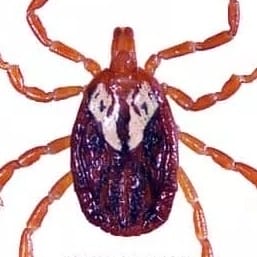
#7 Winter Tick
Scientific Name: Dermacentor albipictus
Winter ticks are small, light brown creatures, and are a common sight in wooded or grassy areas across the country. These can be particularly harmful to wildlife, affecting moose, deer, elk, and caribou, but are not as dangerous to humans.
They have a distinct black shield-like area behind their mouthparts. Unlike other ticks mentioned on this list, these ticks can latch on to their food source as larvae, however, this food source is almost never humans.
As their name suggests, these ticks are more active in the winter months. However, you may come across their path all year long, so be mindful as these ticks have even been spotted beyond their typical range, especially if their hosts move about.
Also Read: Homeowners Guide To Tick Control
Jamison Pest and Lawn: Your One-Stop Shop For Tick Removal In Tennessee
We hope that with this blog post, you are now more aware of the types of ticks that can harm you and your pets. If you find ticks near your home, or on your pets, and fear infestations, call the best Tennessee pest control company, Jamison Pest and Lawn.
We’ve been serving Memphis, and the surrounding areas for years, and have been able to offer the best tick extermination services. Contact us today at 901-452-1505 to speak with one of our professionals and learn more about how we can help you.



